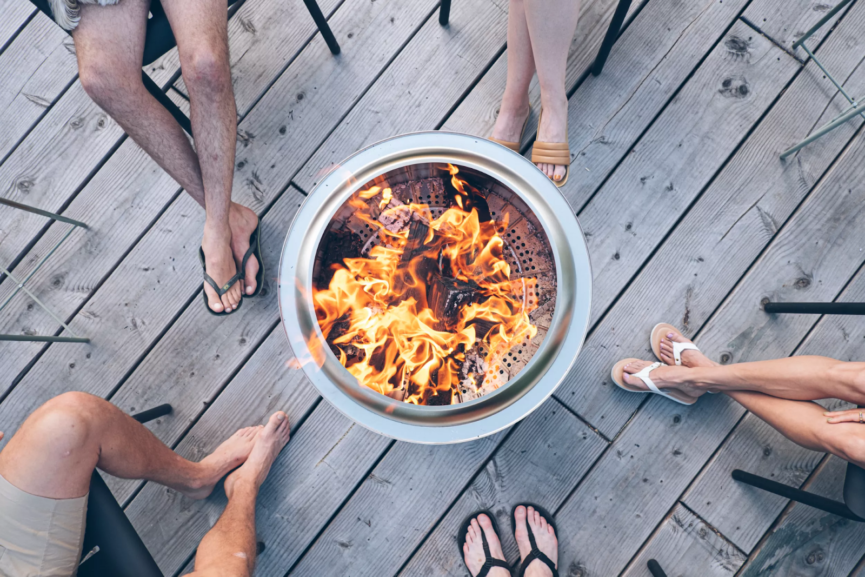By Taysha Billinger
Hey there! My name is Taysha, and I’m fairly new to the Solo Stove Team. Nice to meet you! While Solo Stove provides countless guides, blog posts, and videos, getting the perfect flame can still be a bit of a struggle at first.
Here’s an embarrassing story from one of my first attempts at lighting it on my own:
The setting was a 4th of July get-together with all of my friends. Being the show off I am, I got the bright idea to bring my Ranger, expecting everyone to praise my impeccable taste in fire pits. I packed the most aromatic wood, the fire pit, the Stand to go with it, and a few damp fire starters I left out in the rain a few days before. I told everyone I could make the flames smokeless in under 20 minutes. One hour later, with my flame ring upside down, logs sticking out of the top, and a baby fire giving more smoke than flame, I sat there embarrassingly with what felt like a million eyes on me, wondering what went wrong.
Sound familiar? Here’s what I was missing:
The Three Pillars of Fire
So, I was right– I could have made my flames smokeless in under 20 minutes and enjoyed it too. But there was a mark I missed, so let’s get on target.
Whether smokeless or not, every fire needs three things to survive: consistent oxygen, lots of heat, and quality fuel. Missing any of these components will get you the same experience I had.
Fuel
A quality fire starts with quality fuel that:
- Is kiln-dried or seasoned
- Fits in your fire pit (for a Solo Stove fire pit, you’ll want your logs below your flame ring to kick off that secondary burn, but we’ll get to that in the Secondary Burn section.)
- Has a low-moisture content
Here’s a scenario you’ve probably been through:
Have you ever run water over a hot pan, and steam immediately shoots off from it? This same concept applies to super damp fuel. When moisture meets heat, it immediately becomes water vapor, essentially “putting out” or weakening your flame. So, when a very moist log meets fire, it immediately produces lots of vapor, or in this case, “smoke.” Damp fuel makes for a tiny fire that’ll die quickly and gives off more smoke than flame.
This brings me to the next fire-essential element:
Heat
In order to get a fire started in the first place, you need something called combustion. Simply put, combustion is just the process of burning something. Not-so-simply-put, combustion combines quality fuel and oxygen which produces heat. Now, a proper flame is a self-sustaining thing. While it needs heat to start, it’ll make enough heat as it burns to keep itself going.
But without the #1 source of all fires, oxygen, it won’t be able to produce its self-sustaining heat, resulting in a flame dead on arrival. And that’s why the next element is paramount.
Oxygen
Just like you and I, fire needs oxygen to survive because air feeds fire; it’s what keeps it going. Without oxygen, you wouldn’t be able to start a fire, and without proper airflow, your Solo Stove Fire Pit wouldn’t be smokeless.
360° Airflow Technology
All Solo Stove Fire Pits are made with two sets of burn holes: One set at the bottom (external) and the other at the top (internal). Air is pulled in through the bottom holes and fans your flames from below, promoting combustion. As the air cycles throughout your fire pit, it’ll eventually become hot enough to kick off the iconic smokeless process.
Secondary Burn
As talked about before, all fires need quality fuel and heat. Our fire pits take those components and amplify their benefits times 10. So when you line your Ranger or Yukon with kiln-dried wood and light up a few fire starters, your fire pit’s vent holes will constantly pull air in to fan your flames. As the combustion emits more and more heat, the incoming air will eventually get extremely hot and burn off smoke from your fire. This is called Secondary Burn, and airflow is the crux of its process.
So, now, if someone randomly approached you on the sidewalk and asked, “what’s essential for a successful fire?” you can confidently say, “oxygen, heat, and fuel,” and know precisely why. Congratulations on your newfound knowledge and happy combustion-ing!

